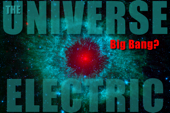X-rays Betray Giant [Electrical] Particle Accelerator in the Sky
02/11/08
A recent news release has just come to light that cannot but reinforce the position of Electric Universe model advocates, and highlight the misunderstanding of typical astronomers, astrophysicists and commentators.
X-rays betray giant particle accelerator in the sky
A very simple question lies at the heart of this post. How do you power a particle accelerator?
Another very simple question can also be asked. How does one go about creating synchrotron radiation (in this case, powerful x-rays)?
Before we answer these two simple questions, let us review the above news release.
ESA’s orbiting gamma-ray observatory, Integral, has made the first unambiguous discovery of highly energetic X-rays coming from a galaxy cluster. The find has shown the cluster to be a giant particle accelerator.
There is nothing at all ambiguous about this statement. The comparison is directly between the action of a galaxy cluster and the action of a particle accelerator. Once the comparison has been made, questions necessarily arise which must be answered.
The X-rays detected are too energetic to originate from quiescent hot gas inside the cluster and suggest instead that giant shockwaves must be rippling through the gas. This has turned the galaxy cluster into a giant particle accelerator.
Most of the X-rays come from hot gas in the cluster, which in the case of Ophiuchus is extremely hot, at 100 million degrees Kelvin.
At 100 million degrees Kelvin (approximately 180,000,000 degrees Fahrenheit), the materials in question no longer qualify as “hot gas.” At that temperature, the materials would be fully ionized plasma. Let us hope that the term “hot gas” was simply intended as a fudge factor aimed at an audience of laypersons. Otherwise, one might term it “hot air”. Though that carries a slightly different connotation.
It also seems that the only model that astronomers currently apply to things observed to accelerate charged particles (or to create energetic emissions such as x-rays or gamma rays) in space includes some kind of mechanical “collision,” “shockwave,” “shock front,” or just “shock.”
They might be “shocked” to find out that dentists don’t create x-rays by banging things together. They use an electrical device to generate x-rays via controlled electrical currents. Thus, there is an alternative explanation for high-energy emissions and for the acceleration of charged particles. No “collision” or “galactic merger” required.
“Two groups analysed the data. One group saw the component but the other did not,” says Dominique Eckert, Integral Science Data Centre (ISDC), University of Geneva, Switzerland. So Eckert and colleagues from ISDC launched an investigation into the mystery.
They turned to Integral and its five-year, all-sky survey and found that ESA’s orbiting gamma-ray observatory did show an unambiguous detection of highly energetic X-rays, coming from the Ophiuchus cluster of galaxies. These X-rays can be produced in two ways, both of which involve high-energy electrons.
Again, nothing is ambiguous here. One set of scientists thought they saw an x-ray signal, another didn’t. Where scientists disagreed, a new investigation was launched that definitively ended the discussion. The x-ray signal was real.
This is a positive thing. Where scientists disagree, debate should naturally ensue. If debate cannot resolve the issue, then a newer better set of data and experimental tests should be designed to resolve the issue to the satisfaction of all, as unambiguously as possible. This is how science is supposed to work.
Unfortunately, such is not always the case. Scientists of all stripes can be subject to confirmation bias, wherein they prefer and cling tenaciously to their dearly held beliefs even in the face of strong evidence refuting those ideas. In the arena of the sciences, this may mean that new papers that challenge age-old assumptions are denied publication, scientists whose research is deemed “out of line” with current thought may be denied tenure or even “excommunicated” from the church of science and academe. It seems anything goes except the reconsideration of current ideas that have ceased to be falsifiable in the minds of scientists. Science is not supposed to work based on faith, but on clear, empirical data collection and analysis. When the scientific method is abandoned, the results cease to be science.
Let us now return to the recent news release:
The first option is that the electrons are caught in the magnetic field threading through the cluster. In this case, the electrons would spiral around the magnetic field lines, releasing synchrotron radiation in the form of X-rays.
The electrons would be extremely energetic, carrying over 100 000 times the energy of the electrons in the alternative scenario, which is that the electrons are perhaps colliding with microwaves left over from the origin of the Universe and now bathe all of space. In such collisions, the electrons lose some energy, emitted as X-rays.
The first option above is the most likely (charged particles spiraling at relativistic speeds with an accompanying magnetic field). If I may be self-referential, I will refer to my immediately prior Thunderblog entry (conveniently timed).
The above description of synchrotron radiation is relatively apt. In fact, spiraling charged particles are a fairly common electrical formation in plasma. This formation is the cause of such filamentary shapes as static discharges, lightning, and the glowing discharges in a standard off-the-shelf plasma globe (plasma lamp; sometimes referred to as “lightning balls” or “lightning globes”). It is also one of the more stable formations that plasma can take in the presence of an electric current, stable enough to efficiently transfer electric current over interstellar and intergalactic distances.
In my prior entry I emphatically stated that we must revisit James Clerk Maxwell’s work and understand that he unified the forces of electricity and magnetism. They are flip sides of the same coin. According to the electromagnetic field Wikipedia article:
The electromagnetic field is a physical field produced by electrically charged objects. It affects the behaviour of charged objects in the vicinity of the field.
[…]
The field can be viewed as the combination of an electric field and a magnetic field. The electric field is produced by stationary charges, and the magnetic field by moving charges (currents); these two are often described as the sources of the field. The way in which charges and currents interact with the electromagnetic field is described by Maxwell's equations and the Lorentz Force Law.
In essence, what Maxwell is saying is that the electric field is created by stationary electric charges and the magnetic field is created by moving electric charges (an electric current).
Where we see one, we must consider the other. Where we see dynamic electric currents (see my prior Thunderblog entry for additional details, as it’s slightly more complicated), we must assume that they create a dynamic magnetic field. Likewise, where we see a dynamic magnetic field, we must consider that it is generated by a source electric current.
So, when the article speaks of synchrotron radiation being generated by charged particles spiraling in a magnetic field, what can we conclude but that the two are intimately related? Such a flow of charged particles constitutes an electric current. Such an electric current generates a dynamic magnetic field. The two are intimately related phenomena.
In fact the two can even interplay with one another to form various structures. Under some circumstances, instabilities develop. One is filamentation wherein charges tend to form rope-like structures. Another is the “pinch” wherein there is a feedback loop that increases the magnetic field and the current density, thus constricting the flow into a smaller and more energetic region. This is the process that occurs in lightning, giving it its characteristic thin, tubular shape. It’s amazing the things you learn once you know the correct questions to ask and the processes to investigate further.
Returning to the news release, let us come to both their conclusions and ours:
Determining which of these scenarios is correct is the next job for the team. They plan to use radio telescopes to measure the magnetic field of the galaxy cluster. They also plan to use the High Energy Stereoscopic System (HESS) in Namibia. This giant telescope looks for the brief flash of light generated when highly energetic gamma rays collide with particles in Earth’s atmosphere. If HESS sees such flashes coming from Ophiuchus, then the astronomers will know that the synchrotron scenario is correct.
Either way, the electrons themselves are most likely to be accelerated to high energies by shockwaves travelling through the cluster gas. The shockwaves are set up when two clusters collide and merge. The question is how recently Ophiuchus swallowed its companion cluster.
In the synchrotron scenario, the highly energetic electrons cool very quickly. If the team find this to be the case, then the collision must still be in progress. In the case of microwave scattering, cooling takes a long time and the collision could have taken place at any time in the past.
Once the scientists know, they will be able to properly understand the history of the cluster. One thing is already certain; nature has transformed the galaxy cluster into a powerful particle accelerator, perhaps 20 times more powerful than CERN’s Large Hadron Collider (LHC), which begins operation in Switzerland this summer.
I look forward to the confirmation of gamma rays and the synchrotron emission hypothesis, with implications for the electrical structure of the “particle accelerator.” However, I disagree with their assessment that the charged particles are most likely accelerated by “shockwaves” due to “collision.” In fact, the physics tool kit includes more ways of accelerating particles than “brute force.” Sometimes finesse is required.
In fact, in an electrical environment, the easiest way to accelerate charged particles is with a voltage potential difference across an electric field. No shockwaves or collisions required. No fuss, no mess, just electrodynamics. From the lab to the cosmos in one simple confirmative step.
It will likely also relieve my dentist to know that he won’t have to call the galaxy-smasher repairman when his x-ray machine breaks down. He can just call his local electrical engineer to diagnose the problem.
So, now that we’ve had an incisive look at the article, let us return to the questions I referred to at the beginning of this Thunderblog entry. In case you don’t recall what they were, let me paraphrase them:
How do you power a particle accelerator? How does one go about creating synchrotron radiation (in this case, powerful x-rays)?
By now we should have a moderate inkling of what lines of inquiry to follow in order to find out, should we wish to investigate on our own. However, in order to save you the trouble of typing “particle accelerator” or “synchrotron radiation” into Google.com. Wikipedia.org or Answers.com, I’ll lay it out for you.
The Answers.com entry on “particle accelerator” is particularly helpful with respect to these questions, summarizing the definition from several independent resources (encyclopedias mostly).
From the Sci-Tech Encyclopedia summary on Answers.com:
Particle accelerator
An electrical device which accelerates charged atomic or subatomic particles to high energies. The particles may be charged either positively or negatively. If subatomic, the particles are usually electrons or protons and, if atomic, they are charged ions of various elements and their isotopes throughout the entire periodic table of the elements.
[…]
Particle accelerators fall into two general classes -- electrostatic accelerators that provide a steady dc potential, and varieties of accelerators that employ various combinations of time-varying electric and magnetic fields.
Electrostatic accelerators
Electrostatic accelerators in the simplest form accelerate the charged particle either from the source of high voltage to ground potential or from ground potential to the source of high voltage. All particle accelerations are carried out inside an evacuated tube so that the accelerated particles do not collide with air molecules or atoms and may follow trajectories characterized specifically by the electric fields utilized for the acceleration. The maximum energy available from this kind of accelerator is limited by the ability of the evacuated tube to withstand some maximum high voltage.
The Columbia Encyclopedia summary offered the following snippet:
Design of Particle Accelerators
[…]
All accelerators use electric fields (steady, alternating, or induced) to speed up particles; most use magnetic fields to contain and focus the beam.
Considerably more detail and supplementary information is available at Answers.com’s entry on particle accelerators than is covered here. If you want more detail, feel free to give them a visit. Well worth a read, despite the length of the page (summarizing multiple sources).
What have we learned here? It shouldn’t come as a shock that particle accelerators are electrical devices. After all, in order to power the large magnetic fields and electric fields used to confine the plasma and to accelerate the particles, large electromagnets are used. The electromagnets only generate a magnetic field when an electric current is run through them. No electric current, no magnetic field. It’s really that simple. The magnetic field is a function of the flow or movement of electric charges.
Put simply, a particle accelerator is powered by electricity (high current density).
In answering the question about synchrotron radiation, the Answers.com summary is again useful.
The Sci-Tech Encyclopedia summary had the following to say:
Electromagnetic radiation emitted by relativistic charged particles curving in magnetic or electric fields.
[…]
The radiation has many features (natural collimation, high intensity and brightness, broad spectral bandwidth, high polarization, pulsed time structure, small source size, and high-vacuum environment) that make it ideal for a wide variety of applications in experimental science and technology. Very powerful sources of synchrotron radiation in the ultraviolet and x-ray parts of the spectrum became available when high-energy physicists began operating electron synchrotrons in the 1950s.
The Brittanica Concise Encyclopedia is useful insofar as it tells us:
Synchrotron Radiation
[…]
It is so called because it is produced by high-speed particles in a synchrotron.
To sum up, synchrotron radiation is electromagnetic radiation (light waves) emitted by charged particles spiraling in a magnetic field and approaching the speed of light. It displays the natural ability to collimate particle flows (the ability to get particles to move in parallel in approximately the same direction), to put out radiation at varying wavelengths and to be generated in a near vacuum (extremely sparse plasma). Synchrotron radiation was given its name because it was first observed in synchrotron particle accelerators.
A synchrotron is a type of particle accelerator that uses varying magnetic fields to confine and guide the particles and varying electric fields to accelerate the particles to relativistic speeds (approaching the speed of light). Again, electrical current is necessary to run the particle accelerator that creates the synchrotron radiation.
So, it seems that astronomers have just opened Pandora’s box, and the end result appears to be the likely incontrovertible proof of electrical engineers’ claims about electric currents in interplanetary, interstellar and intergalactic space.
Conclusions:
It appears that the discovery of synchrotron radiation and the analogy of a “particle accelerator in the sky” have raised specific questions about the power source for the particle accelerator, and the questions can no longer be dodged. It is necessary to revisit James Clerk Maxwell, Kristian Birkeland, Hannes Alfven, Irving Langmuir and other forebears of the Plasma Cosmology and Electric Universe models.
Maxwell integrated our understanding of electric charges and electric field, electric currents and magnetic fields. Where we see electric currents we must consider the magnetic fields they spawn. Where we see magnetic fields, we must consider their source electric currents. We cannot divorce one from the other, lest we fall into a morass of “mysterious” physics and turn science into metaphysics.
Unfortunately, current press releases and many scholarly papers attempt to do just that and deal with only the magnetic fields with no reference to their source currents. Hence we find ourselves in an astronomical morass that cannot be resolved until the role of electricity is once again acknowledged, and the theory and language used matches the data coming at us from all directions.
Let’s open some new vistas in the field of astronomy and astrophysics together. This century holds great promise of scientific discovery and delights, if we choose to view them through the proper lens to bring them into focus. Only then can we truly understand what we’re seeing and make sense of it all. Let’s use all the tools at our disposal!
Permalink to this article.
Public comment may be made on this article on the
Thunderbolts Forum/Thunderblogs (free membership required).
|

Michael Gmirkin is a technology enthusiast with a keen interest
in exploring the electrical nature of the universe.
My Archives
Chronological Archives
Archives by Author
Archives by Subject
Thunderblogs home
|




